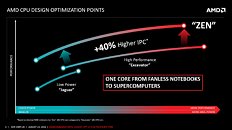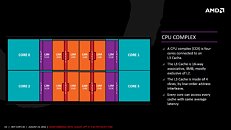Tuesday, August 23rd 2016

AMD Details ZEN Microarchitecture IPC Gains
AMD Tuesday hosted a ZEN microarchitecture deep-dive presentation in the backdrop of Hot Chips, outlining its road to a massive 40 percent gain in IPC (translated roughly as per-core performance gains), over the current "Excavator" microarchitecture. The company credits the gains to three major changes with ZEN: better core engine, better cache system, and lower power. With ZEN, AMD pulled back from its "Bulldozer" approach to cores, in which two cores share certain number-crunching components to form "modules," and back to a self-sufficient core design.
Beyond cores, the next-level subunit of the ZEN architecture is the CPU-Complex (CCX), in which four cores share an 8 MB L3 cache. This isn't different from current Intel architectures, the cores share nothing beyond L3 cache, making them truly independent. What makes ZEN a better core, besides its independence from other cores, and additional integer pipelines; subtle upscaling in key ancillaries such as micro-Op dispatch, instruction schedulers; retire, load, and store queues; and a larger quad-issue FPU.AMD also improved the cache system. The hierarchy is similar to pre-Bulldozer AMD architectures, with L3 cache being shared between full-fledged cores, and each core having a dedicated L2 cache. The L1 cache is now write-back (and not write-through), the SRAM that makes up the L2 and L3 caches are faster.The L3 cache SRAM has 5 times higher bandwidth than the L3 cache found on current AMD architectures. The L1 and L2 caches have 2 times the bandwidth. Load from cache to FPU is now faster. The core is endowed with 64 KB each of L1I cache, 32 KB L1D cache; 512 KB of dedicated L2 cache, and 8 MB of L3 cache shared between four cores in a CCX.ZEN introduces simultaneous multi-threading (SMT) to AMD processors. Intel's SMT implementation is the popular HyperThreading Technology. AMD's SMT is similar in that each core is addressed to as two threads, with each thread competing for the resources on the core.The third key area is lower-power, and this is attributed not just to the silicon-level gains yielded from the move to the 14 nm FinFET process. The design team focused on power-draw from the very inception of the ZEN core project. The L1 write-back cache, and the Op cache lower power-draw; the various components on ZEN processors feature aggressive clock-gating, although there's no power-gating.AMD expanded the ISA CPU instruction-sets, with AVX, AVX2, BMI1, BMI2, AES, RDRAND, sMEP, SHA1/SHA256, ADX, CFLUSHopt, XSAVEC/XSAVES/XRSTORS, and SMAP. The company also introduced a few AMD-exclusive instruction sets, which can be taken advantage of for better performance, including CLzero, and PTE Coalescing.
Beyond cores, the next-level subunit of the ZEN architecture is the CPU-Complex (CCX), in which four cores share an 8 MB L3 cache. This isn't different from current Intel architectures, the cores share nothing beyond L3 cache, making them truly independent. What makes ZEN a better core, besides its independence from other cores, and additional integer pipelines; subtle upscaling in key ancillaries such as micro-Op dispatch, instruction schedulers; retire, load, and store queues; and a larger quad-issue FPU.AMD also improved the cache system. The hierarchy is similar to pre-Bulldozer AMD architectures, with L3 cache being shared between full-fledged cores, and each core having a dedicated L2 cache. The L1 cache is now write-back (and not write-through), the SRAM that makes up the L2 and L3 caches are faster.The L3 cache SRAM has 5 times higher bandwidth than the L3 cache found on current AMD architectures. The L1 and L2 caches have 2 times the bandwidth. Load from cache to FPU is now faster. The core is endowed with 64 KB each of L1I cache, 32 KB L1D cache; 512 KB of dedicated L2 cache, and 8 MB of L3 cache shared between four cores in a CCX.ZEN introduces simultaneous multi-threading (SMT) to AMD processors. Intel's SMT implementation is the popular HyperThreading Technology. AMD's SMT is similar in that each core is addressed to as two threads, with each thread competing for the resources on the core.The third key area is lower-power, and this is attributed not just to the silicon-level gains yielded from the move to the 14 nm FinFET process. The design team focused on power-draw from the very inception of the ZEN core project. The L1 write-back cache, and the Op cache lower power-draw; the various components on ZEN processors feature aggressive clock-gating, although there's no power-gating.AMD expanded the ISA CPU instruction-sets, with AVX, AVX2, BMI1, BMI2, AES, RDRAND, sMEP, SHA1/SHA256, ADX, CFLUSHopt, XSAVEC/XSAVES/XRSTORS, and SMAP. The company also introduced a few AMD-exclusive instruction sets, which can be taken advantage of for better performance, including CLzero, and PTE Coalescing.













80 Comments on AMD Details ZEN Microarchitecture IPC Gains
Even if AMD is fluffing numbers to reach 40% (which I'm sure they are to some extent), it matters not because I think it is reasonable to expect no less than 15-20% performance increase. I would be perfectly happy with that.
Even the most loyal are in a 'poop or get off the pot' mentality. Sandybridge like performance isn't enough.
In your mind, you see people as irritated with AMD and having abandoned ship. With that mentality, I would have dumped AMD 7-9 years ago. Yet here we are after all of these years still buying AMD, still appreciating value, and still supporting the underdog. There are many people who like me have their own reasons for purchasing AMD.
Enthusiasts aren't where the money is at. AMD has been in the market of 'value' for quite some time now. Zen isn't about being the king of the hill; it is about being the comeback architecture (which scales into the server market) that AMD needs to start making serious profit again and gaining market share.
You know, it's really Déjà vu. I am about to pull trigger on 5820k in a month or two.
People are tired of them not coming close to Intel. Sure, things are fine if you like glass ceilings on things, and 20% isn't anything to shake a stick at, but many people really REALLY want AMD right up there with INtel. There are always those what will flock to the underdog 'because', as there are those that will always flock to the front runner. Its the fat in the middle they are playing for. The better AMD comes out, the more swings that way. If they match/close in IPC to Intel, they hit a home run... 20% is not (remotely) "close" to Intel. Closer? Surely. :)
In my mind? Look at this and nearly every other forum not named AMD or Rage 3D. :p
*AMD FX-8350
Windows ~ 4 min
Linux ~ 2:30 min
*i7-3770
Windows ~ 3:30 min
Linux ~ 2 min
*i7-4770
Windows ~ 2 min
Linux ~ 1:30 min
source: blenderartists.org/forum/showthread.php?314084-Which-CPU-is-better-for-Blender-AMD-FX-8350-vs-i7-3770k
Now AMD showed a 8 core zen cpu who could trade punch with a 8 core from intel, according to those data, that's a freaking huge improvement on that particular test. We don't know the full picture yet, but we do know that zen is going to be way better than excavator. 2017 will be when we will know if zen got 40% in task that are not multithreaded.
And look how shitty windows is. Screw you, M$.
Zen benchies under linux may be off the charts for what it is. BD is very competitive in parallelized loads (that are optimized, so nothing on windows lol).
Testing the overclocking capabilities of a new generation is a lot of fun and the community gets really involved. Can't wait.
PR is highly important at this stage. The key thing people need to realize is Jim Keller designed ZEN. It's going to be a monster CPU. Just like how it was in the good old Athlon 64 days.
They also have something called Hyper Share.
www.hypertransport.org/default.cfm?page=Home
Since hyper transport was a based DEC technology can't remember what it was called but it was used in there DEC alpha and the EV6 bus.
Jim Keller who worked for DEC designed the original AMD K8 aka Athlon 64 ( last time AMD had a Pentium 4 killer was winning.) Is the same guy who designed ZEN so lets keep fingers crossed.
i hope is not gonna be more expensive than i5 6600k . from what i read, 258$ is the expected price